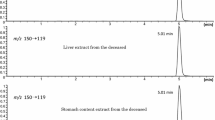Abstract
Intravenous administration of 200 mg of amphetamine to 12 human subjects induced a stage of euphoria noticeable for 10–12 hr followed by signs of dysphoria which were noticeable early but reached a maximum at 14 hr after injection and remained for 48 hr. The subjective effects of amphetamine could be blocked by α-methyltyrosine. The duration of this antiamphetamine action was more than 24 hr. Pharmacokinetic studies in amphetamine- dependent subjects using large intravenous doses were undertaken to relate measurable pharmacokinetic parameters to the clinical manifestations of amphetamine abuse such as paranoid psychosis and development of tolerance. Subjects having an acidic urine exhibited a relatively mild psychosis, while the psychotic symptoms were aggravated in patients with an alkaline urine. The plot of plasma half- life against mean urinary pH during the first 20 hr yielded a striking correlation. For every increase in unit of urinary pH, there was an increase of plasma half-life of about 7 hr. The intensity of the psychosis in patients having an alkaline urine appeared to be dependent on the metabolite levels rather than on the plasma levels of unchanged drug. A pH-dependent excretion of p-hydroxyamphetamine was noted, and it was found that this metabolite was eliminated slower than the parent compound. The second major metabolite was norephedrine.
Similar content being viewed by others
References
G. Inghe. The present state of abuse and addiction to stimulant drugs in Sweden. InSymposium on Abuse of Central Stimulants (F. Sjoqvist and M. Tottie, eds.), Almquist and Wiksell, Stockholm, 1969.
E. Davidoff and E. C. Reifenstein. The stimulating action of benzedrine sulfate.JAMA 108: 1770–1776 (1937).
D. E. Rosenberg, A. B. Wolbach, E. J. Miner, and H. Isbell. Observations on direct and cross tolerance with LSD and d-amphetamine in man.Psychopharmacologia 5: 1–15 (1963).
C. A. Haertzen, H. E. Hill, and R. E. Belleville. Development of the addiction research center inventory (ARCI): Selection of items that are sensitive to the effects of various drugs.Psychopharmacologia 4: 155–166 (1963).
L. M. Gunne, E. Änggård, and L. E. Jonsson. Blockade of amphetamine effects in human subjects. InInternational Institute on the Prevention and Treatment of Drug Dependence, Tongue and Tongue, Lausanne, 1970, pp. 249–255.
J. Cavanaugh, J. D. Griffith, J. Held, and J. A. Oates. Experimental psychosis induced by the administration of d-amphetamine. InInternational Symposium on Amphetamines and Related Compounds (E. Costa and S. Garatinni, eds.), Raven Press, New York, 1970, pp. 551–555.
L. C. F. Hansson. Evidence that the central action of (+)-amphetamine is mediated via catecholamines.Psychopharmacologia 10: 289–297 (1967).
J. J. M. Stolk and R. H. Rech. Effect of reserpine on accumulation and removal ofd- amphetamine-3H.Biochem. Pharmacol. 18: 2786–2788 (1969).
A. Weissman, B. K. Koe, and S. Tenen. Antiamphetamine effects following inhibition of tyrosine hydroxylase.J. Pharmacol. Exptl. Therap. 151: 339–352 (1966).
A. Randrup and I. Munkvad. Role of catecholamines in amphetamine excitatory response.Nature 211: 540 (1966).
P. Janssen, C. Niemegeers, and K. Schellekens. Is it possible to predict the clinical effects of neuroleptic drugs (major tranquilizers) from animal data?Drug Res. (Arzneim.-Forsch.) 15: 104–107 (1965).
L. E. Jonsson, L. M. Gunne, and E. Änggård. Effects of alphamethyltyrosine in amphetamine-dependent subjects.Europ. J. Clin. Pharmacol. 2: 27–29 (1969).
D. E. Espelin and A. K. Done. Amphetamine poisoning.New Engl. J. Med. 278: 1361–1365 (1968).
K. M. Taylor and S. H. Snyder. Amphetamine differentiation byd andl isomers of behavior involving brain norepinephrine and dopamine.Science 168: 1487–1489 (1970).
E. Änggård, L. M. Gunne, and F. Nicklasson. Gas Chromatographic determination of amphetamine in blood, tissue and urine.Scand. J. Clin. Lab. Invest. 26: 137–143 (1970).
L. E. Jonsson and K. Sjostrom. A rating scale for evaluation of the clinical course and symptomatology in amphetamine psychosis.Brit. J. Psychiat. 117: 661–665 (1970).
E. Änggård, L. M. Gunne, L. E. Jonsson, and F. Nicklasson. Pharmacokinetic and clinical studies on amphetamine dependent subjects.Europ. J. Clin. Pharmacol. 3: 3–11 (1970).
M. D. Milne, B. H. Scribner, and M. D. Crawford. Non-ionic diffusion and the excretion of weak acids and bases.Am. J. Med. 24: 709–729 (1958).
A. M. Asatoor, B. R. Galman, J. R. Johnson, and M. D. Milne. The excretion of dexamphetamine and its derivatives.Brit. J. Pharmacol. 24: 293–300 (1965).
A. Beckett and M. Rowland. Urinary excretion kinetics of amphetamine in man.J. Pharm. Pharmacol. 17: 628–639 (1965).
A. H. Beckett, J. A. Salmon, and M. Mitchard. Relation between blood levels and urinary excretion of amphetamine under controlled acidic and under fluctuating urinary ph values using amphetamine-14C.J. Pharm. Pharmacol. 21: 251–258 (1969).
J. H. Bland.Disturbances of Fluid Balance, W. B. Saunders, Philadelphia and London, 1956.
M. Rowland. Amphetamine blood and urine levels in man.J. Pharm. Sci. 58: 508–509 (1969).
E. Cösta and A. Groppetti. Biosynthesis and storage of catecholamines in tissues of rats injected with various doses of d-amphetamines. InInternational Symposium on Amphetamines and Related Compounds (E. Costa and S. Garatinni. eds.), Raven Press, New York, 1970.
B. M. Angrist and S. Gershon. The phenomenology of experimentally induced amphetamine psychosis-Preliminary observation.Biol. Psychiat. 2: 95–107 (1970).
J. H. Cavanaugh, J. D. Griffith, and J. A. Oates. Effect of amphetamine on the pressor response to tyramine: Formation ofp-hydroxynorephedrine from amphetamine in man.Clin. Pharmacol. Therap. 11: 656–664 (1970).
J. M. Davis, E. J. Kopin, L. Lemberger, and J. Axelrod. Effects of urinarypH on amphetamine metabolism.Ann. N.Y. Acad. Sci. 179: 493–501 (1971).
M. Goldstein and J. F. Contrera. The substrate specificity of phenylethylamine-β-hydroxylase.J. Biol. Chem. 237: 1898–1902 (1962).
J. Caldwell, L. G. Dring, and R. T. Williams. Norephedrine as metabolites of14C amphetamine in urine in man.Biochem. J. 129: 23–24 (1972).
L. M. Gunne and L. Galland. Stereoselective metabolism of amphetamine.Biochem. Pharmacol. 16: 1374–1377 (1967).
L. M. Gunne. The urinary output ofd- andl-amphetamine in man.Biochem. Pharmacol. 16: 863–869 (1967).
Author information
Authors and Affiliations
Rights and permissions
About this article
Cite this article
Gunne, L.M., Änggård, E. Pharmacokinetic studies with amphetamines-relationship to neuropsychiatric disorders. Journal of Pharmacokinetics and Biopharmaceutics 1, 481–495 (1973). https://doi.org/10.1007/BF01059787
Published:
Issue Date:
DOI: https://doi.org/10.1007/BF01059787




